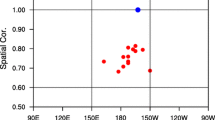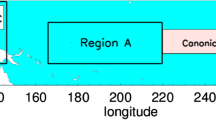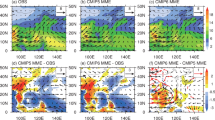Abstract
Over the recent three decades sea surface temperate (SST) in the eastern equatorial Pacific has decreased, which helps reduce the rate of global warming. However, most CMIP5 model simulations with historical radiative forcing do not reproduce this Pacific La Niña-like cooling. Based on the assumption of “perfect” models, previous studies have suggested that errors in simulated internal climate variations and/or external radiative forcing may cause the discrepancy between the multi-model simulations and the observation. But the exact causes remain unclear. Recent studies have suggested that observed SST warming in the other two ocean basins in past decades and the thermostat mechanism in the Pacific in response to increased radiative forcing may also play an important role in driving this La Niña-like cooling. Here, we investigate an alternative hypothesis that common biases of current state-of-the-art climate models may deteriorate the models’ ability and can also contribute to this multi-model simulations-observation discrepancy. Our results suggest that underestimated inter-basin warming contrast across the three tropical oceans, overestimated surface net heat flux and underestimated local SST-cloud negative feedback in the equatorial Pacific may favor an El Niño-like warming bias in the models. Effects of the three common model biases do not cancel one another and jointly explain ~50% of the total variance of the discrepancies between the observation and individual models’ ensemble mean simulations of the Pacific SST trend. Further efforts on reducing common model biases could help improve simulations of the externally forced climate trends and the multi-decadal climate fluctuations.













Similar content being viewed by others
References
Ashok K, Behera SK, Rao SA, Weng H, Yamagata T (2007) El Niño Modoki and its possible teleconnection. J Geophys Res 112:C11007. doi:10.1029/2006JC003798
Bellenger H, Guilyardi E, Leloup J, Lengaigne M, Vialard J (2014) ENSO representation in climate models: from CMIP3 to CMIP5. Clim Dyn 42:1999–2018
Cane MA, Clement AC, Kaplan A, Kushnir Y, Pozdnyakov D, Seager R, Zebiak SE, Murtugudde R (1997) Twentieth-century sea surface temperature trends. Science 275:957–960. doi:10.1126/science.275.5302.957
Chikamoto Y, Timmermann A, Luo JJ, Mochizuki T, Kimoto M, Watanabe M, Ishii M, Xie SP, Jin FF (2015) Skilful multi-year predictions of tropical trans-basin climate variability. Nat Commun 6:6869. doi:10.1038/ncomms7869
Clement AC, Seager R, Cane MA, Zebiak SE (1996) An ocean dynamical thermostat. J Clim 9:2190–2196
Dee DP, Uppala SM, Simmons AJ, Berrisford P, Poli P, Kobayashi S, Andrae U, Balmaseda MA, Balsamo G, Bauer P, Bechtold P, Beljaars ACM, van de Berg L, Bidlot J, Bormann N, Delsol C, Dragani R, Fuentes M, Geer AJ, Haimberger L, Healy SB, Hersbach H, Hólm EV, Isaksen L, Kållberg P, Köhler M, Matricardi M, McNally AP, Monge-Sanz BM, Morcrette JJ, Park BK, Peubey C, de Rosnay P, Tavolato C, Thépaut JN, Vitart F (2011) The ERA-Interim reanalysis: configuration and performance of the data assimilation system. Q J R Meteorol Soc 137:553–597. doi:10.1002/qj.828
DiNezio PN, Clement AC, Vecchi GA, Soden BJ, Kirtman BP (2009) Climate response of the equatorial Pacific to global warming. J Clim 22(18):4873–4892
Dommenget D, Floeter J (2011) Conceptual understanding of climate change with a globally resolved energy balance model. Clim Dyn 37:2143–2165
Dommenget D, Haase S, Bayr T, Frauen C (2014) Analysis of the slab-ocean El Niño atmospheric feedbacks in observed and simulated ENSO dynamics. Clim Dyn 42:3187–3205
England MH, McGregor S, Spence P, Meehl GA, Timmermann, A, Cai W, Sen Gupta A, McPhaden MJ, Purich A, Santoso A (2014) Recent intensification of wind-driven circulation in the Pacific and the ongoing warming hiatus. Nat Clim Change 4:222–227
Flato G, Marotzke J, Abiodun B, Braconnot P, Chou SC, Collins W, Cox P, Driouech F, Emori S, Eyring V, Forest C, Gleckler P, Guilyardi E, Jakob C, Kattsov V, Reason C, Rummukainen M (2013) Evaluation of climate models. In: Stocker TF et al (eds) Climate change 2013: the physical science basis. contribution of working group I to the fifth assessment report of the intergovernmental panel on climate change. Cambridge University Press, Cambridge, pp 741–866
Fyfe JC, Gillett NP (2014) Recent observed and simulated warming. Nat Clim Change 4:150–151
Gu DF, Philander SH (1997) Interdecadal climate fluctuations that depend on exchanges between the tropics and extratropics. Science 275:805–807
Guemas V, Doblas-Reyes FJ, Andreu-Burillo I, Asif M (2013) Retrospective prediction of the global warming slowdown in the past decade. Nat Clim Change 3:649–653
Guilyardi E, Braconnot P, Jin FF, Kim ST, Kolasinski M, Li T, Musat I (2009) Atmosphere feedbacks during ENSO in a coupled GCM with a modified atmospheric convection scheme. J Clim 22:5698–5718
Ham YG, Kug JS (2015) Role of north tropical Atlantic SST on the ENSO simulated using CMIP3 and CMIP5 models. Clim Dyn 45(11):3103–3117
Huang B, Banzon VF, Freeman E, Laurimore J, Liu W, Peterson TC, Smith TM, Thorne PW, Woodruff SD, Zhang HM (2015) Extended reconstructed sea surface temperature version 4 (ERSST.v4), Part I. upgrades and intercomparisons. J Clim 28:911–930
Kalnay E, Kanamitsu M, Kistler R, Collins W, Deaven D, Gandin L, Iredell M, Saha S, White G, Woollen J, Zhu Y, Leetmaa A, Reynolds R, Chelliah M, Ebisuzaki W, Higgins W, Janowiak J, Mo K, Ropelewski C, Wang J, Jenne R, Joseph D (1996) The NCEP/NCAR 40-year reanalysis project. Bull Am Meteor Soc 77:437–471
Kanamitsu M, Ebisuzaki W, Woollen J, Yang S, Hnilo J, Fiorino M, Potter G (2002) NCEP-DOE AMIP-II reanalysis (R-2). Bull Amer Meteor Soc 83:1631–1643
Karl TR, Arguez A, Huang B, Lawrimore JH, McMahon JR, Menne MJ, Peterson TC, Vose RS, Zhang HM (2015) Possible artifacts of data biases in the recent surface warming hiatus. Science 348:1066–1067
Kiehl JT, Ramanathan V (1982) Radiative heating due to increased CO2—the role of H2O continuum absorption in the 12–18 Mu-Mregion. J Atmos Sci 39:2923–2926
Kim ST, Cai W, Jin FF, Yu JY (2014) ENSO stability in coupled climate models and its association with mean state. Clim Dyn 42:3313–3321
Klein SA, Soden BJ, Lau NC (1999) Remote sea surface temperature variations during ENSO: evidence for a tropical atmospheric bridge. J Clim 12:917–932
Kobayashi S, Ota Y, Harada Y, Ebita A, Moriya M, Onoda H, Onogi K, Kamahori H, Kobayashi C, Endo H, Miyaoka K, Takahashi K (2015) The JRA-55 reanalysis: general specifications and basic characteristics. J Meteor Soc Jpn 93:5–48
Kociuba G, Power SB (2015) Inability of CMIP5 models to simulate recent strengthening of the walker circulation: Implications for projections. J Clim 28:20–35
Kosaka Y, Xie SP (2013) Recent global-warming hiatus tied to equatorial Pacific surface cooling. Nature 501:403–407
Kug JS, Ham YG, Lee JY, Jin FF (2012) Improved simulation of two types of El Niño in CMIP5 models. Environ Res Lett. doi:10.1088/1748-9326/7/3/034002
Li Y, Li JP, Zhang WJ, Zhao X, Xie F, Zheng F (2015) Ocean dynamical processes associated with the tropical Pacific cold tongue mode. J Geophys Res 120:6419–6435. doi:10.1002/2015JC010814
Li X, Xie SP, Gille ST, Yoo C (2016) Atlantic-induced pan-tropical climate change over the past three decades. Nat Clim Change 6:275–279
Luo JJ, Yamagata T (2001) Long-term El Niño-Southern Oscillation (ENSO)-like variation with special emphasis on the South Pacific. J Geophys Res 106(C10):22211–22227
Luo JJ, Masson S, Roeckner E, Madec G, Yamagata T (2005) Reducing climatology bias in an ocean–atmosphere CGCM with improved coupling physics. J Clim 18:2344–2360
Luo JJ, Sasaki W, Masumoto Y (2012) Indian Ocean warming modulates Pacific climate change. Proc Natl Acad Sci 109:18701–18706
Mantua NJ, Hare SR (2002) The Pacific decadal oscillation. J Oceanogr 58:35–44
Mantua NJ, Hare SR, Zhang Y, Wallace JM, Francis RC (1997) A Pacific interdecadal climate oscillation with impacts on salmon. Bull Amer Meteor Soc 78:1069–1079
Marotzke J, Forster PM (2015) Forcing, feedback and internal variability in global temperature trends. Nature 517:565–570
McGregor S, Timmermann A, Stuecker MF, England MH, Merrifield M, Jin FF, Chikamoto Y (2014) Recent Walker circulation strengthening and Pacific cooling amplified by Atlantic warming. Nat Clim Change 4:888–892
McPhaden MJ, Lee T, McClurg D (2011) El Niño and its relationship to changing background conditions in the tropical Pacific Ocean. Geophys Res Lett 38:L15709. doi:10.1029/2011GL048275
Meehl GA, Arblaster JM, Fasullo JT, Hu A, Trenberth KE (2011) Model-based evidence of deep-ocean heat uptake during surface-temperature hiatus periods. Nat Clim Change 1: 360–364
Meehl GA, Hu A, Arblaster M, Fasullo JT, Trenberth KE (2013) Externally forced and internally generated decadal climate variability associated with the Interdecadal Pacific Oscillation. J Clim 26:7298–7310
Meehl GA, Teng H, Arblaster JM (2014) Climate model simulations of the observed early-2000s hiatus of global warming. Nat Clim Change 4:898–902
Pan YH, Oort AH (1983) Global climate variations connected with sea surface temperature anomalies in the eastern equatorial Pacific Ocean for the 1958–1973 period. Mon Weather Rev 111:1244–1258
Philander SGH, Gu D, Lambert G, Li T, Halpern D, Lau NC, Pacanowski RC (1996) Why the ITCZ is mostly north of the Equator. J Clim 9:2958–2972
Power S, Casey T, Folland C, Colman A, Mehta V (1999) Inter-decadal modulation of the impact of ENSO on Australia. Clim Dyn 15:319–324
Rayner NA, Parker DE, Horton EB, Folland CK, Alexander LV, Rowell DP, Kent EC, Kaplan A (2003) Global analyses of sea surface temperature, sea ice, and night marine air temperature since the late nineteenth century. J Geophys Res 108(D14):4407. doi:10.1029/2002JD002670
Reynolds RW, Rayner NA, Smith TM, Stokes DC, Wang W (2002) An improved in situ and satellite SST analysis for climate. J Clim 15:1609–1625
Risbey JS, Lewandowsky S, Langlais C, Monselensan DP, O’Kane TJ, Oreskes N (2014) Well-estimated global surface warming in climate projections selected for ENSO phase. Nat Clim Change 4:835–840
Roberts CD, Palmer MD, McNeall D, Collins M (2015) Quantifying the likelihood of a continued hiatus in global warming. Nat Clim Change 5:337–342
Schmidt GA, Ruedy RA, Miller RL, Lacis AA (2010) Attribution of the present-day total greenhouse effect. J Geophys Res 115:D20106. doi:10.1029/2010JD014287
Schmidt GA, Shindell DT, Tsigaridis K (2014) Reconciling warming trends. Nat Geosci 7:158–160
Seager R, Murtugudde R (1997) Ocean dynamics, thermocline adjustment, and regulation of tropical SST. J Clim 10:521–534
Smith TM, Reynolds RW, Peterson TC, Lawrimore J (2008) Improvements to NOAA’s historical merged land–ocean surface temperature analysis (1880–2006). J Clim 21:2283–2296
Smith DM, Booth BBB, Dunstone NJ, Eade R, Hermanson L, Jones GS, Scaife AA, Sheen KL, Thompson V (2016) Role of volcanic and anthropogenic aerosols in the recent global surface warming slowdown. Nat Clim Change 6:936–940
Solomon A, Newman M (2012) Reconciling disparate twentieth-century Indo-Pacific ocean temperature trends in the instrumental record. Nat Clim Change 2:691–699
Takahashi C, Watanabe M (2016) Pacific trade winds accelerated by aerosol forcing over the past two decades. Nat Clim Change 6:768–772
Taylor KE, Stouffer RJ, Meehl GA (2012) An overview of CMIP5 and the experiment design. Bull Amer Meteor Soc 93:485–498
Vecchi GA (2008) Examining the tropical Pacific’s response to global warming. EOS 89(9):81–83
Watanabe M, Shiogama H, Tatebe H, Hayashi M, Ishii M, Kimoto M (2014) Contribution of natural decadal variability to global warming acceleration and hiatus. Nat Clim Change 4:893–897
Zhang Y, Wallace JM, Battisti DS (1997) ENSO-like interdecadal variability: 1900–93. J Clim 10:1004–1020
Zhang WJ, Li JP, Zhao X (2010) Sea surface temperature cooling mode in the Pacific cold tongue. J Geophys Res 115:C12042. doi:10.1029/2010JC006501
Acknowledgements
The authors thank M. Wheeler, J. Arblaster, H. Hendon, and S. McGregor for their helpful internal reviews and two anonymous reviewers for their helpful comments. G.W. and D. D. are supported by the ARC project “Beyond the linear dynamics of the El Nino Southern Oscillation” (DP120101442) and the ARC Centre of Excellence in Climate System Science (CE110001028).
Author information
Authors and Affiliations
Corresponding author
Rights and permissions
About this article
Cite this article
Luo, JJ., Wang, G. & Dommenget, D. May common model biases reduce CMIP5’s ability to simulate the recent Pacific La Niña-like cooling?. Clim Dyn 50, 1335–1351 (2018). https://doi.org/10.1007/s00382-017-3688-8
Received:
Accepted:
Published:
Issue Date:
DOI: https://doi.org/10.1007/s00382-017-3688-8




